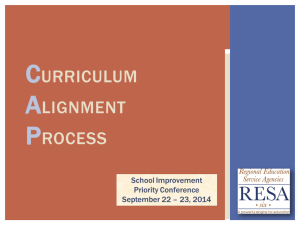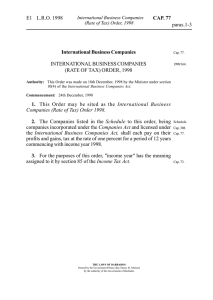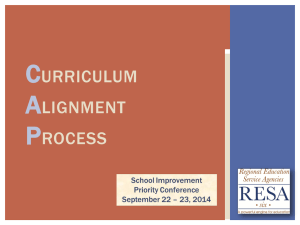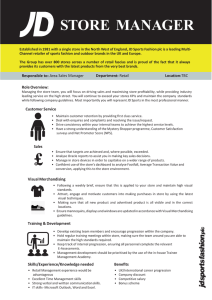C A P URRICULUM
advertisement
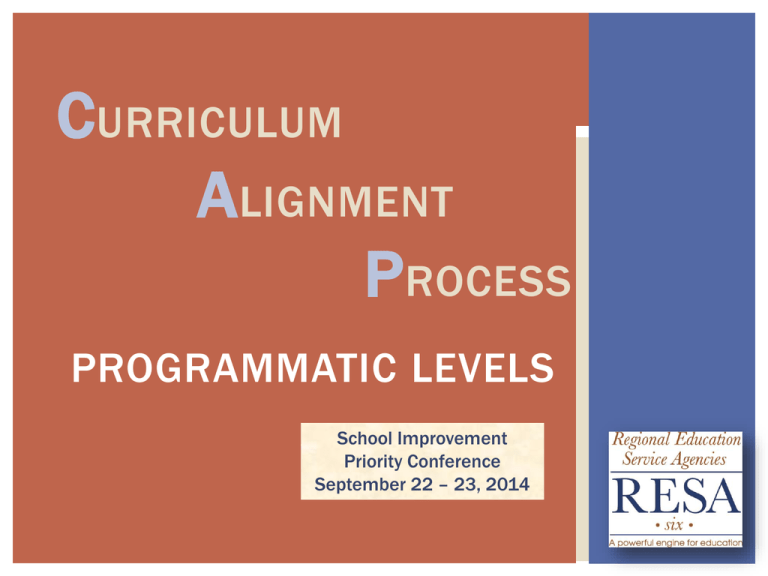
CURRICULUM ALIGNMENT PROCESS PROGRAMMATIC LEVELS School Improvement Priority Conference September 22 – 23, 2014 Acting – Let’s do it Likes to act, try things, plunge in Paying attention to detail – likes to know the who, what, when, where, why, before acting Speculating – likes to look at the big picture, the possibilities, before acting Likes to know that everyone’s feelings have been taken into consideration; that their voices have been heard, before acting COMPASS POINTS: PERSONALIT Y North South East West Directions: •Listen to the descriptions of each point. •Choose the most accurate descriptor… •Move to that area WHAT DIRECTION DO YOU FAVOR? North: ‘Acting.’ Let’s do it! Likes to act, try things, plunge in. South: ‘Caring.’ Likes to know that everyone’s feelings have been taken into consideration; that their voices have been heard, before acting. East: ‘Speculating.’ Likes to look at the big picture, the possibilities, before acting. West: ‘Paying attention to detail.’ Likes to know the who, what, when, where, why before acting. FOLLOW-UP QUESTIONS 1. What are the strengths of our style? (4 Adjectives) 2. What are the limitations of our style? (4 Adjectives) 3. What style do we find most difficult to work with and why? 4. What do other people need to know about us so that we can work together more effectively? NORMS FOR GROUP WORK Start on Time – End on Time Everyone Participates No Finger Pointing Be Here, Now Other Norms? Photo Sources: http://www.celebritiesheight.com/ http//www.cheersboston.com http://www.getjoy.blogspot.com Scenario vs ‘Real Time’ Time Frames Horizontal/Vertical Collaboration Whole Group Discussions – Reflective Questions, Pair 2 & Share, etc. Breaks Teaching Roles and Process Vertical Transitions Between Levels Continue/Follow Up Horizontal/Vertical Collaboration Update Pair 2 & Share Update Progression Documents Related Arts CAP Protocol Elementary: Related Arts teachers will join an assigned grade level group(s) to discuss the gaps they experience in the students’ skill sets. Related Arts will regroup during Steps 2 & 3 to discuss and document course specific needs. High School: Related Arts teachers will collaborate to discuss the gaps they experience in the students’ skill sets. During Step 2, move to assigned groups. During Step 3, discuss and document course specific needs. Middle: Depending on grade span, choose Elementary or High School protocol, or a combination of both. Pair2 and Share CAP REFLECTIVE QUESTIONS In Programmatic Groups “Count Off by 3’s/Programmatic Rooms: ES, MS, HS” to share insight from CAP Process using these questions. 1 . Which Tools were most useful? How did you use the tools? Any adjustments needed? a. Performance Descriptors Mastery Charts b. CAP Progress Document c. NextGen WVCSOs 2. Are there any surprises? Do you see any adjustments for your grade level? 3. What follow -up is needed to embed the CAP Process within your school/County? Have you identified obstacles as you integrate/implement the CAP Process in your school/county? CAP Data Collection Process: An Overview to organize the analysis activity What is the most commonly heard concern from teachers about the grade level(s) before them? Past Future Step 2 Understanding the Past Past Core Step 1 Reviewing the Present Core Step 3 Completing the Present Step 2 Adjusting to the Future Future Related Arts CAP Protocol Elementary: Related Arts teachers will join an assigned grade level group(s) to discuss the gaps they experience in the students’ skill sets. Related Arts will regroup during Steps 2 & 3 to discuss and document course specific needs. High School: Related Arts teachers will collaborate to discuss the gaps they experience in the students’ skill sets. During Step 2, move to assigned groups. During Step 3, to discuss and document course specific needs. Middle: Depending on grade span, choose Elementary or High School protocol, or a combination of both. Step1: Present Alignment For the 1st step: Horizontal Collaboration time scheduled. Review your Current Grade Level teaching position (the Present), and complete the progression document for that grade level by comparing the Performance Descriptors to the skills, vocabulary, and concepts necessary for a student to master the content standard objectives. Review, refine, and align the evidence for their own grade. Rationale: This allows teachers the opportunity to horizontally share progression of skills, vocabulary, and concepts. Work in the Teachers Grade 7 7rd Grade teachers fill-in 7th Grade Progression Document Teachers Grade 8 8th Grade teachers Fill-in 8th Grade Progression Document Descriptors/CSOs Grade 7 Step 1 Reviewing the Present Descriptors/CSOs Grade 8 Teacher Grade 9 Descriptors/CSOs Grade 9 9th Grade teachers Fill-in 9th Grade Progression Document Example Blank CAP Progression Doc: 3rd Grade Civics Example CAP Progression Doc: 3rd Grade Civics 1. Teachers review and rank the Next Gen CSO’s for the Action words. 2. Teachers review and rank key vocab and concepts. 3. Teachers extract language from the Performance Descriptors for Mastery and from their own expertise/experience for evidence/justification of their previous rankings. 4. Space is provided for additional remarks, evidence/justification, or omissions. Completing the CAP Progression Document Part 1 - Focus on the First Column – Critical Skills TOOL KIT Next Gen CSO’s (available online, Teach 21) Example CAP Progression Doc: 3rd Grade Civics 1. Teachers review and rank the Next Gen CSO’s for the Action words. Example Completed CAP Progression Doc: 3rd Grade Civics Completing the CAP Progression Document Part 2 - Focus on the Second Column Key Vocabulary and Concepts TOOL KIT Next Gen CSO’s (available online, Teach 21) Example CAP Progression Doc: 3rd Grade Civics 2. Teachers review and rank key vocab and concepts. Example Completed CAP Progression Doc: 3rd Grade Civics Completing the CAP Progression Document Part 3 - Focus on the Third Column Performance Descriptors for Mastery TOOL KIT Performance Descriptors for Mastery : These quick references of what students must be able to Know, Understand, and Be Able to Do were designed to give teachers true direction to facilitate instruction that guides students toward Mastery of the Next Gen CSO’s. Each Grade level specific poster includes: - All 4 Core subjects and performance descriptions for mastery for the respective CSO categories - A list of the 3 Literacy Shifts in ALL Content Areas - Helpful hints for developing Text -Dependent Questions - RESA 6 FAST team contact info. TOOL KIT Professional Experience Draw from your years of personal experience in the classroom You know what has been ef fective for student achievement Example CAP Progression Doc: 3rd Grade Civics 3. Teachers extract language from the Performance Descriptors for Mastery and from their own expertise/experience for evidence/justification of their previous rankings. Example Completed CAP Progression Doc: 3rd Grade Civics Completing the CAP Progression Document Part 4 - Focus on the Fourth Column Use your Professional Tool Kit Example CAP Progression Doc: 3rd Grade Civics 4. Space is provided for additional remarks, evidence/justification, or omissions. Example Completed CAP Progression Doc: 3rd Grade Civics Step 1 – CAP Reflective Questions Which Tools were most useful? How did you use the tools? Any adjustments needed? a. Performance Descriptors Mastery Charts b. CAP Progress Document c. NextGen WVCSOs Step 2: Alignment, Past Future Vertical Collaboration time scheduled. Grade Level will be divided - collaborate with the Past and the Future. Note similarities and differences in priority skills, vocabulary, and concepts. Reach consensus on Progression Document. Rationale: This allows teachers the opportunity to examine the necessary skills, vocabulary, and concepts students need to progress from one grade level to the next. Look at the ; Hear the Teachers Grade 7 Descriptors/CSOs Grade 7 ½ 7th Grade teachers go with 8rd Grade Part 1 7th Grade Review 7th Grade Progression Document with 8th Grade teachers Part 2 8th Grade Review 8th Grade Progression Document with 7rd Grade teachers Step 2 Understanding the Past Part 3 7th Grade and 8th Grade reach consensus on 7th Grade Progression Document Teachers Grade 8 Descriptors/CSOs Grade 7 ½ 8th Grade teachers go with 7th Grade ½ 8th Grade teachers go with 9th Grade Part 1 8th Grade Review 8th Grade Progression Document with 9th Grade teachers Part 2 Step 2 Adjusting to the Future 9th Grade Review 9th Grade Progression Document with 8th Grade teachers Part 3 Teacher Grade 9 Descriptors/CSOs Grade 9 8th Grade and 9th Grade reach consensus on 8th Grade Progression Document ½ 9th Grade teachers go with 9th Grade Example CAP Progression Doc: 3rd Grade Civics 4. Space is provided for additional remarks, evidence/justification, or omissions. Example Completed CAP Progression Doc: 3rd Grade Civics Step 2 – CAP Reflective Questions Are there any surprises? Do you see any adjustments for your grade level? Step 3: Reconvene with the Present Horizontal Collaboration revisited. Completion of Initial grade specific Progression Document. Rationale: This allows teachers the opportunity to provide direct input on the necessary skills, vocabulary, and concepts students need to enter their grade level. Update the Teachers Grade 7 7rd Grade teachers complete the initial 7th Grade Progression Document Teachers Grade 8 8th Grade teachers complete the initial 8th Grade Progression Document Descriptors/CSOs Grade 7 Step 3 Completing the Present Descriptors/CSOs Grade 8 Teacher Grade 9 Descriptors/CSOs Grade 9 9th Grade teachers complete the initial 9th Grade Progression Document Example CAP Progression Doc: 3rd Grade Civics 1. Teachers review and rank the Next Gen CSO’s for the Action words. 2. Teachers review and rank key vocab and concepts. 3. Teachers extract language from the Performance Descriptors for Mastery and from their own expertise/experience for evidence/justification of their previous rankings. 4. Space is provided for additional remarks, evidence/justification, or omissions. Example Completed CAP Progression Doc: 3rd Grade Civics MS 365 FO R DIGITAL ACCESS/SHARING (SUGGESTED) In order to ease the data collection process, the CAP Progression Documents will be placed on MS Office 365. Benefits: K – 12 th alignment Real-time sharing and template updates Allows for collaboration throughout the year. Access from anywhere via the Internet Step 3 - Reflective Question What follow-up is needed to embed the CAP Process within your school/County? Have you identified obstacles as you integrate/implement the CAP Process in your school/county? Review Process and Reflection Step 2 Understanding the Past Past Core Step 1 Reviewing the Present Core Step 3 Completing the Present Step 2 Adjusting to the Future Future Pair2 Use Worries to… …Brainstorm Solutions and Share Keys to Success Principals/Administrators are an integral to process Continual Collaboration: Both Horizontal & Vertical Teacher Professional Experience is a KEY Tool in this process • You know your students. • Your experience knows what works! Revisit and update CAP on a scheduled basis COUNT OFF 1: Elementary Room 2: Middle School Room 3: High School Room Discussion of Reflective Questions with all 3 programmatic levels CAP Hat Trick T h re e P rog rammat ic Leve l s – T h re e Re fl e c t ive Qu e s t i ons 1 . Which Tools were most useful? How did you use the tools? Any adjustments needed? a. Performance Descriptors Mastery Charts b. CAP Progress Document c. NextGen WVCSOs 2. Are there any surprises? Do you see any adjustments for your grade level? 3. What follow -up is needed to embed the CAP Process within your school/County? Have you identified obstacles as you integrate/implement the CAP Process in your school/county? THANK YOU! Contact Information : Marian Kajfez … … … … … D i r e c t o r o f P r o g r a m s m ka j f e z @ k 1 2 . w v. u s O f f i c e : 3 0 4 - 2 31 - 3 8 0 6 Joe Paolo………… …… … D i r e c t o r o f S p e c i a l E d u c a t i o n j p a o l o @ k 1 2 . w v. u s O f f i c e : 3 0 4 - 2 31 - 3 8 2 3 C e l l : 3 0 4 - 31 2 - 2 21 0 Jon Pollock … … … … … … … C o o r d i n a t o r o f C u r r i c u l u m a n d I n s t r u c t i o n j p o l l o c k @ k 1 2 . w v. u s O f f i c e : 3 0 4 - 2 31 - 3 8 3 0 C e l l : 3 0 4 - 31 2 - 9 6 76 Mar y Kay Reisinger … C o o r d i n a t o r o f S c h o o l I m p r o v e m e n t & Te c h n i c a l A s s i s t a n c e m r e i s i n g @ k 1 2 . w v. u s O f f i c e : 3 0 4 - 2 31 - 3 817 Cher yl Tuba … … … … … … . . … Te c h n i c a l A s s i s t a n c e a n d S u p p o r t S p e c i a l i s t c t u b a @ k 1 2 . w v. u s 3 0 4 - 2 31 - 3 81 8
